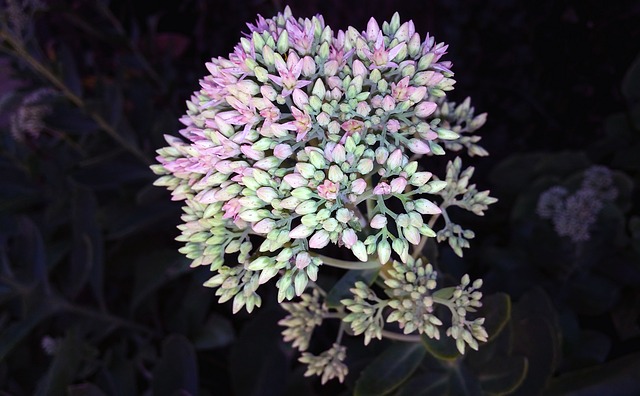 |  |  |   |   |
  |  |
The stem is single, erect, 40-80 cm tall. The leaves are fleshy, glabrous, oppositely arranged or brought together in threes, elongated elliptic, distantly lobed along the edge, heart-shaped or rounded at the base, often surrounding the stem. The flowers are small, with 5 petals, white, yellowish or pinkish. The flowers are located at the end of the stem in a shield-shaped inflorescence. Fruit someni. The plant blooms in July-August. The fruits ripen in September-October.
Most recipes use fresh scallions. They are collected during flowering, because this is when the plant contains the most biologically active elements. Lilacs are harvested in dry weather, in the morning, immediately after the dew has dried. Freshly cut leaves are stored in a dry, cool and dark room. In addition, during the next three days, the concentration of biologically active substances increases significantly.
Dry the leaves of the Orpine in a well-ventilated, dark room. Drying can also be done in a forced dryer at a temperature not exceeding 40C. The smell of the drug is weak and peculiar. The drug can be stored for two years.
Roots are dug in autumn, September-October. After digging, they are cleaned from the soil, often also rinsed with running water, then cut into finer parts. Can be stored for 3 years.
It is important to know that when the plant is dried slowly, it can continue to grow, the flowering process also continues, which often negatively affects the drug. Therefore, the mass to be dried is chopped, washed and dried at a temperature of 60C! Further drying can be done as we discussed above.
It contains many organic acids - alpha-ketoglutaric acid, citric acid, malic acid, isocitric acid, succinic acid, oxalic acid, glyceric acid, acetic acid, fumaric acid). Amino acids - aspartic acid and glutamic acid. Carbohydrates in the great fortune are found in the form of mono-, di- and polysaccharides, such as fructose, glucose, sucrose, sedoheptulose and others, in which the soluble polygalacturon pectin predominates.
Fortunately, there are also phenolic natural substances, such as: phenolic glycosides (quercetin, kaempferol, isorhamnetin and myricetin); catechins; caffeic acid and chlorogenic acid; cynarin; coumarins. The plant also contains a large amount of biologically active substances. Among them, we can highlight ascorbic acid and carotonoids, which are in high concentrations in the plant. Traces of alkaloids have also been found in the leaves.
The surface part of the plant contains alkali 8.65%, macroelements (mg/g): potassium 21.80, calcium-24.40, magnesium- 17.10, iron-0.20; trace elements: magnesium-0.11, copper-0.71, zinc-0.28, chromium-0.16, aluminum-0.22, barium-2.88, vanadium-0.09, selenium-6.86, nickel-0.28, strontium-1.94, lead-0.14, boron-8.00mkg/year.
Medicinal significance
Orpine is a biogenic stimulator that increases metabolic processes in tissues and promotes their regeneration, has a tonic and anti-inflammatory effect.
The plant is used for the treatment of poorly healing wounds, after severe trauma with a lot of blood loss, as well as for the treatment of chronic inflammations of the nasal cavity. The plant shows good results in the treatment of periodontitis.
To prepare the juice, the plant is washed, rinsed and passed through a meat grinder, the juice is squeezed out and mixed with water in a 1:1 ratio. Diluted juice is boiled for 1-3 minutes, stored in the refrigerator and used by a teaspoon three times a day, during meals.
Such juice is effective for treating inflammation of the female line. This juice can also be massaged into the gums, thus strengthening them.
The juice is used to treat chronic ischemic heart disease with frequent pain syndrome, lung and heart failure, gastric and duodenal ulcers, and chronic liver and gall bladder diseases. The juice of the elderberry promotes bone growth, which is very useful during the treatment period after fractures.
In pharmacology, preparations of the great fortune are used as biogenic stimulators, because they increase metabolic processes in tissues and increase regeneration processes. In addition, they act as anti-inflammatory and tonic agents.
Preparations are made from the leaves and roots of the plant, they are used to treat festering wounds, burns and cuts to speed up their healing. Such remedies are also used to get rid of skin warts.
